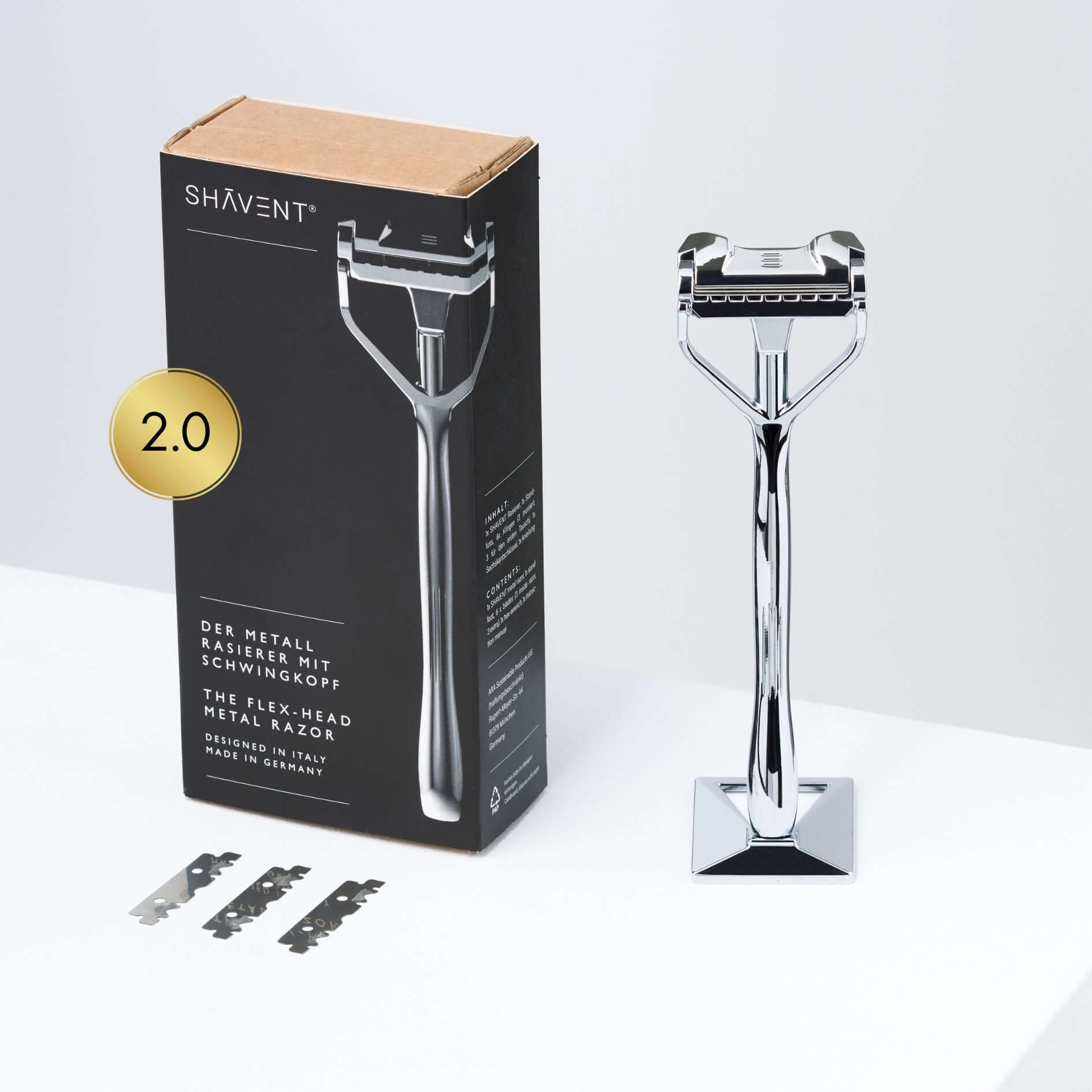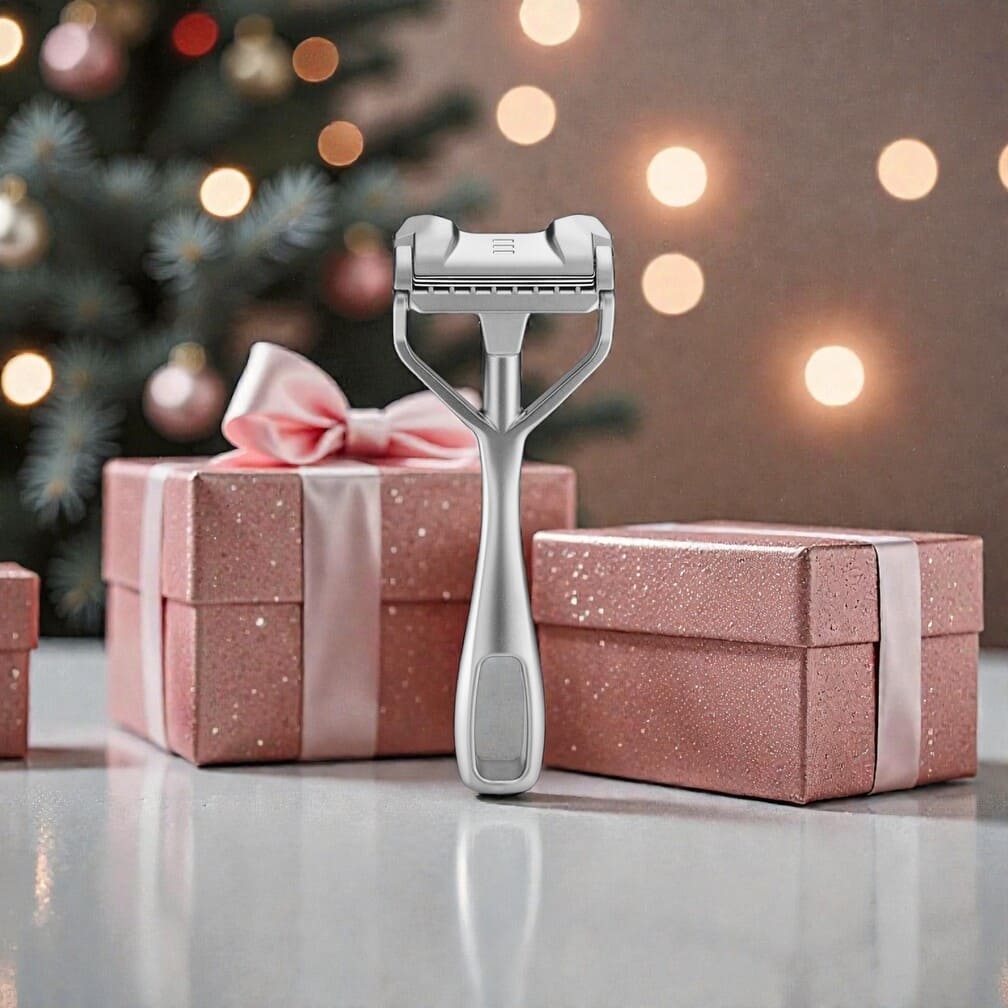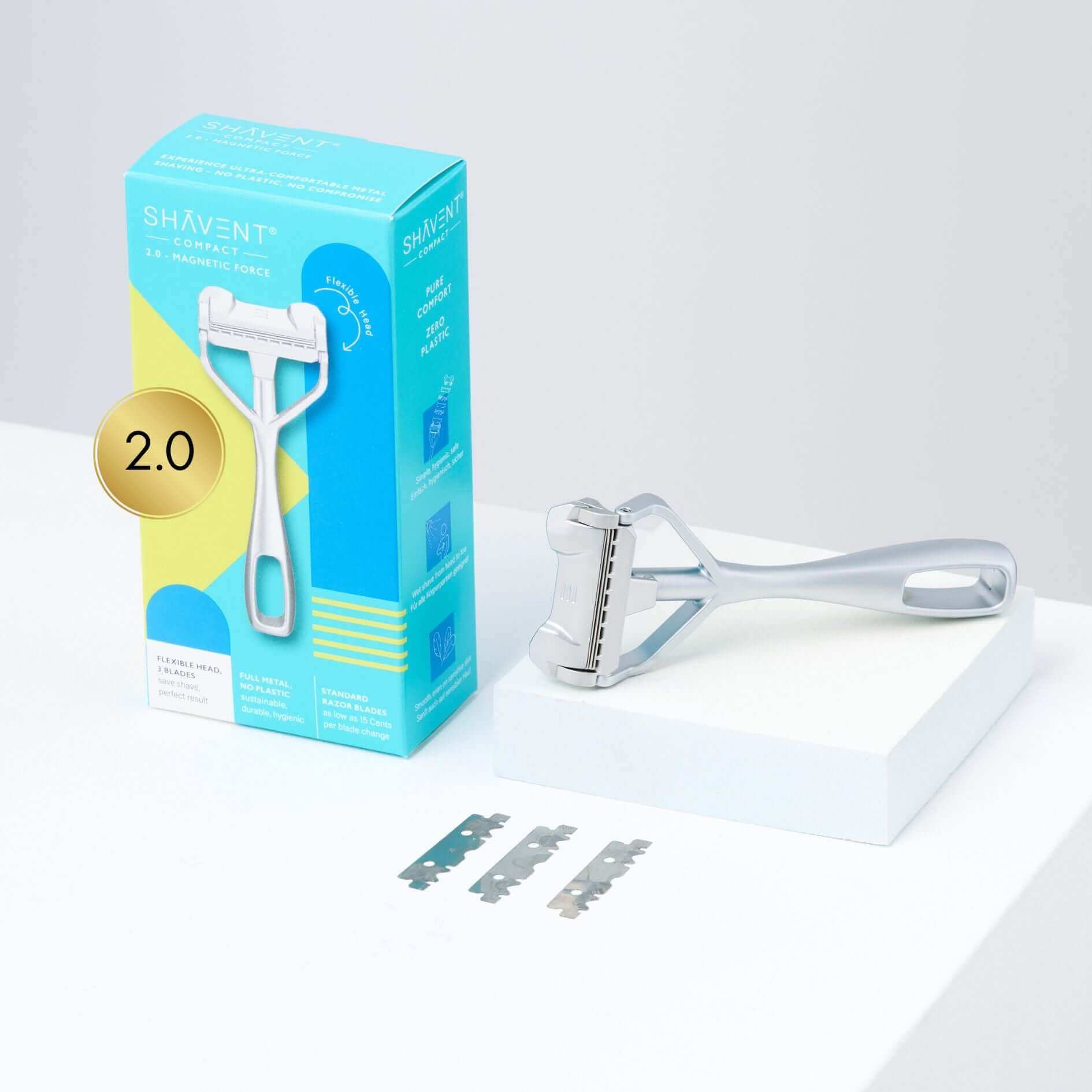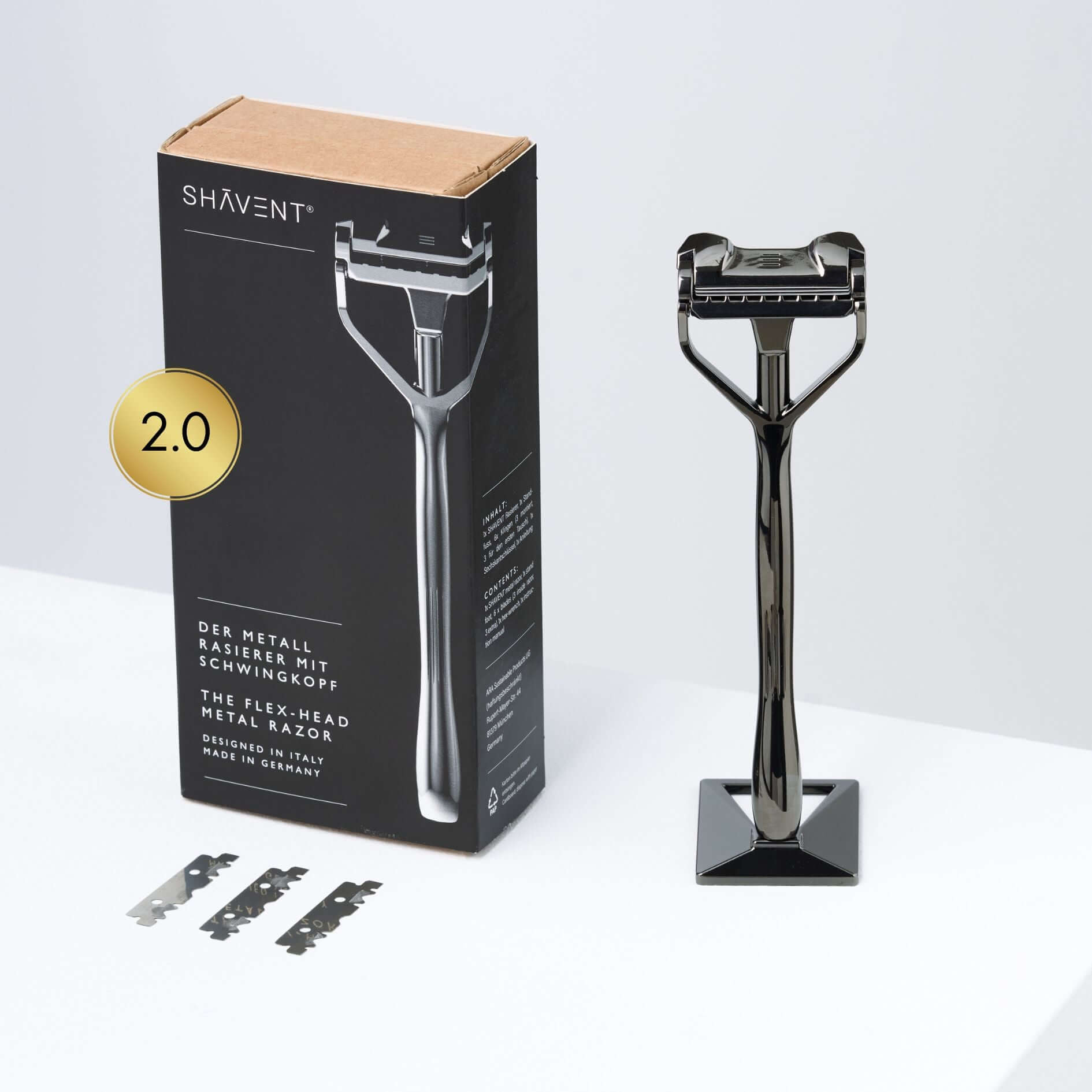In this blog article you will find out which shave a safety razor is suitable for and the best way to shave your legs and genital area. You will learn whether the safety razor prevents skin irritation, the differences in design and quality and experiences women have had with the safety razor. The safety razor is also being tested: who is better? The safety razor or the SHAVENT?
1. For which shave is a safety razor suitable and for which not?
2. Tips and tricks for shaving legs with a safety razor
3. Is the safety razor also suitable for intimate shaving?
4. Do I get less skin irritation from the safety razor?
5. Design and quality: A brief summary of the differences
6. Safety razor experience: What women report about shaving with a razor
7. Alternatives to safety razors: test: who is better? razor or SHAVENT
For which shave is a safety razor suitable and for which not?
You can theoretically shave all parts of your body with a safety razor. For women, a safety razor with a closed comb is better than one with an open comb, as the shave is gentler.
With a little time and skill, a safety razor is suitable for visible and flat areas on the body, such as the legs. However, care should be taken in areas such as ankles or knees, as injuries can quickly occur here. The use of a safety razor in the intimate area is not recommended, however, as it can prove difficult to maintain the correct angle of approx. 30-45 degrees. This can quickly lead to unwanted injuries.
However, if you don't have the time or inclination to perform a traditional shave like a safety razor, a razor with a flexible head like the SHAVENT is more appropriate. Because the oscillating head automatically adapts to all areas of the body and shaves larger areas in less time without having to compromise on sustainability.
Tips and tricks for shaving legs with a safety razor
Just think about the feeling of slipping into a freshly made bed with velvety soft, clean-shaven legs - with these tips and tricks you can be sure of this feeling after shaving your legs with a safety razor:
The perfect preparation: With a safety razor you should always shave wet. When shaving your legs, it is best not to shave until you have finished showering or bathing, as this softens the hair and makes shaving with a safety razor particularly gentle. Make sure your skin is wetted with lukewarm water before shaving to open the pores and allow for a smooth shave. Skin irritation can be prevented by using shaving foam, shaving gel or even oil on your legs - you can also use normal shower gel, as long as it "slips"!
The right technique: So that you don't have strawberry legs after shaving - i.e. black spots on your skin - you should make sure to let the safety razor glide over your legs in gentle and even strokes without pressing it on the skin. Start with gentle short vertical strokes on the shin and shave around your leg until you reach the calf. Avoid shaving multiple times over one area as this will cause unnecessary skin irritation. Always remember the angle of attack to avoid lacerations. You should take your time when shaving, especially on the knees and ankles, and shave without pressure. The risk of cutting is increased in "bony" areas, but with a little practice you can also shave this area.
The feel-good moment after the shave: To ensure that your skin is silky smooth after shaving with a safety razor, you should hold your legs under cold water immediately after shaving to close the pores and avoid skin irritation. To soothe and disinfect your stressed skin after shaving, we recommend applying a gentle aftershave lotion or body lotion. Avoid heavily scented products, however, as they can irritate sensitive skin.
Is the safety razor also suitable for intimate shaving?
Intimate shaving in women is a sensitive issue, with many women reaching for a safety razor to achieve a close and gentle shave. However, you should be aware of the dangers of shaving in the intimate area. The bikini area is more visible and can be shaved with practice and the right angle. Here you should use short, gentle strokes to remove the hair and apply as little pressure as possible to avoid skin irritation.
In the intimate area, shaving with a safety razor is something for professionals. You have no overview of the area to be shaved and the angle of attack can hardly be maintained. If you still want to dare to shave your intimate area, approach it slowly and shave first in the direction of hair growth to avoid razor bumps.
A razor with a flexible head, such as the SHAVENT, is much more comfortable for areas on the body that are not visible and significantly reduces the risk of cuts.
Do I get less skin irritation from the safety razor?
With a safety razor, I always have silky smooth legs after shaving and never have skin irritations again?
It's not that easy. It is true that shaving with a safety razor is closer to the skin and therefore the shave is much closer. A blade also tends to irritate the skin less. Nevertheless, every new razor is a change and the skin has to get used to the new shave first. It is important that you always shave with fresh blades so that the hair is not torn off, but cut off cleanly. It also helps to shave only once over each skin area to avoid skin irritation.
Basically, every body is different and reacts differently. Therefore, it cannot be ruled out that skin irritations can occur after shaving with a safety razor.
A tip to prevent skin irritation: get your skin really wet before shaving and use shaving foam, shaving gel or even oil to make the skin supple and protect it while you shave.
Design and quality: a brief summary of the differences
Not every safety razor is the same - the most important differences in design and quality are summarized here:
The blades: Only one blade is ever inserted into a safety razor. Most blades are made of steel or brass. Steel blades are more durable and don't rust as easily, while brass blades give better shaving results as they are softer and more conformable.
The handle: Safety razors are available with many different handles. The handles can be made of different materials such as wood, plastic or rubber. A high-quality handle material is particularly important, as it should be robust, durable and non-slip.
The closure: There are safety razors that have a locking mechanism and others that don't. This prevents the blades from falling out of the handle.
The price: Safety razors come in a wide range of prices. From cheap disposable models to high-quality, durable safety razors - everything is included. The quality and performance of the safety razor is usually related to the price.
When deciding which safety razor is right for you, you should consider which functions and characteristics are most important to you.
Safety razor experience: What women report about shaving with a safety razor
Experience reports about shaving with a safety razor are very different. There are some women who are great with a safety razor and have become adept at finding the perfect angle of attack so they don't cut themselves with it. Other women are not at all satisfied with the safety razor because they are afraid of the safety razor, they often cut themselves, you have to be careful and for this reason it takes much longer to shave.
For all those who find a safety razor too dangerous and time-consuming, a wet razor with a flexible head such as the SHAVENT is more suitable. Thanks to the oscillating head, the SHAVENT adapts optimally to your body contours and thus ensures a safe and comfortable shave.
Alternatives to the safety razor: test: who is better? razor or SHAVENT
We tested: The safety razor vs. the SHAVENT!
15 women were asked to test the safety razor for two weeks and then the SHAVENT for two weeks.
Who won the duel?
The testers rated the two sustainable wet razors according to different categories.
The results show that both razors shave closely, have inexpensive blades, are sustainable and durable. Nevertheless, the SHAVENT is clearly the test winner with 13/15 women. The differences in ratings were particularly high in the following categories:
The swing head: While the safety razor has a fixed head, the SHAVENT has a flexible head. The SHAVENT thus adapts optimally to the contours of the body, while the safety razor must always be held at the perfect angle to avoid injuries. That's why the SHAVENT is the clear winner here.
The razor blades: A full standard blade is placed in a safety razor, while 3 standard half-blades are placed in the SHAVENT. 14/15 women rated shaving with the SHAVENT as more comfortable and gentler due to the three blades. Thus, the SHAVENT is also the clear test winner in this category.
The full body shave: 13/15 women perceived shaving the whole body as safer and more comfortable with the SHAVENT than with the safety razor. Because the SHAVENT can glide faster over the skin thanks to the flexible head. With a safety razor, on the other hand, shaving the whole body takes much longer because the perfect angle of attack always has to be found. In addition, the testers found it difficult and dangerous to use the safety razor in the intimate area, while that was not a problem with the SHAVENT. In this category, too, the SHAVENT is the clear test winner.
Would you like to read more benefits and feedback on the SHAVENT? Let the SHAVENT convince you: SHAVENT Schwingkopfrasierer-Set










